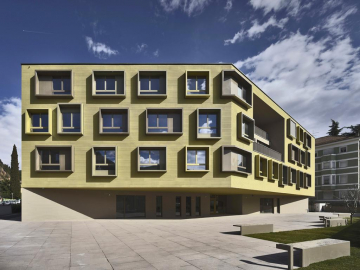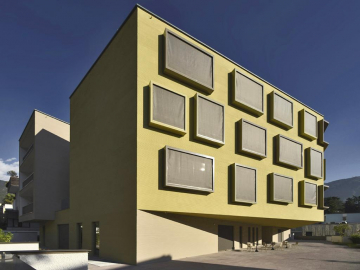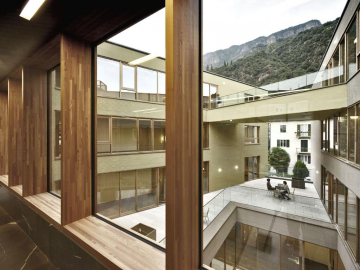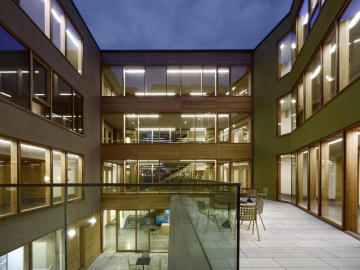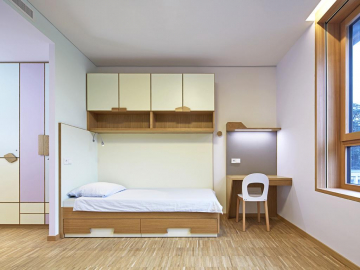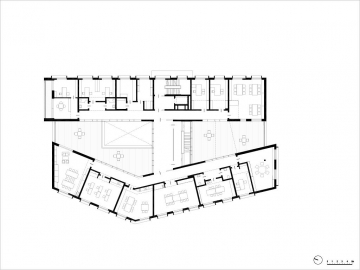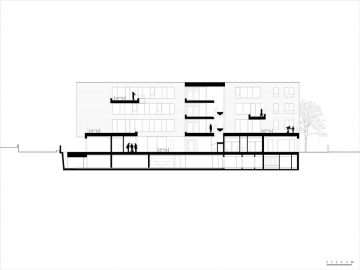Centre for Psychiatric Rehabilitation
The new psychiatric center is a health facility whose scope is to create a community within the local community where residents, patients, and caregivers can work together towards long-term mental health solutions. The building calibrates a spectrum of indoor and outdoor spaces to engender an environment of collaboration and well-being.
The new psychiatric rehabilitation center with an independent sheltered housing unit is nestled within the urban fabric of Bolzanos historically renown Gries residential district. Architectural strategies for the siting, massing and character of the project work to break down both the psychological and physical barriers traditionally associated with mental health facilities. With a highly visible site located along the neighborhoods main street, the center uses a vocabulary more allied to residential programs than institutional ones. A generous forecourt at the entry area with direct access from the street to all the public functions located at the ground level creates a much-needed point of release in the dense neighborhood and serves as an informal platform for exchange and support to the centers residents and their families.
Project description
The new psychiatric rehabilitation center with an independent sheltered housing unit is positioned within the urban fabric of Bolzanos historically renown Gries residential district. Sited along the neighborhoods main street, the center presents itself as a residential building rather than a health-care facility and takes on the chromatic character of the surrounding area with a rhythmic palette of earthy colours that have grown to characterize the neighborhood over the years.
The building is comprised of a base with a rectangular footprint from which two separate, 3-storeyed volumes cantilever outwards to create an inner courtyard open to the sky and crisscrossed by bridging terraces. A central stair connects these two upper buildings and delineates the inner courtyard into two separate patios whereby spaces with varying degrees of privacy and views have been carved out. The entry area with its colourful seating area and adjoining outdoor court is a social hub around which all the more public functions such as the main dining hall, seminar room visitor rooms, exercise room and woodshop all rotate to create a vibrant place to meet and socialize. The therapy and administrative functions are located at the first floor and extend outside to the large first-floor patios while the upper two levels house the private rooms and sheltered housing component of the project. Throughout the building, circulation routes are punctuated by outdoor spaces and the common living areas.
The hallways serving the private rooms overlook the inner courtyard and therefore move away from the double-loaded corridor typically seen in hospital design to permit a more airy and sunny environment. Views across the two buildings promote a connectiveness between the residents without compromising needs for protection and privacy. Indeed the call to balance open, social spaces with more domestic, circumscribed spaces accompanied the design process.
The interiors of the project further develop the residential tone of the center where warm, soft hues prevail. Colourful accents in the common kitchens and living rooms break away from the muted tones of the interiors while the bedrooms make for a light-hearted palette of pastels. The furniture is largely custom made with an un-expectantly exuberant detailing of oak and laminate finishes.
Sustainable aspects of the work
Careful budgetary planning enabled the building to fall under the second highest green certification category (Casa Clima A) with an energy coefficient of 16kWh/m²a. Solar panels, radiant heating and cooling in the horizontal ceiling systems, along with an efficient building envelope contribute to an affordable and easy to maintain, energy conscious building.


